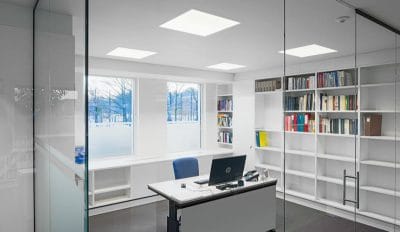
Illumination assessment
Poor illumination can result in:
- Insufficient light — not enough light for the requirements of employees.
- Glare – too much light for the requirements of employees.
- Improper contrast.
- Poorly distributed light.
- Flicker.
Poor illumination can be a safety hazard, resulting in misjudgement of the position, shape or speed of an object, which can lead to incidents and injury. Poor illumination can also affect the quality of work, and overall productivity, specifically in situations where precision is required.
Poor illumination can also be a health hazard, since too much or too little light causes eye strain, and may cause eye discomfort (burning, etc.) and headaches.
The amount of light we need varies and depends on:
- The type of task being done (such as demands for speed and accuracy).
- The type of surface (does it reflect or absorb light).
- General work area.
- Individual’s vision.
The amount of light falling on a surface is measured in units called lux. Depending on the factors above, adequate general illumination is usually between 500 and 1000 lux when measured 76 cm above the floor.*
Examples of industrial and office tasks and the recommended light levels are in the table below.
| Recommended Illumination Levels* | |
| Type of Activity | Ranges of Illuminations (Lux)** |
| Public spaces with dark surroundings | 20-50 |
| Simple orientation for short temporary visits | 50-100 |
| Working spaces where visual tasks are only occasionally performed | 100-200 |
| Performance of visual tasks of high contrast or large scale | 200-500 |
| Performance of visual tasks of medium contrast or small size | 500-1000 |
| Performance of visual tasks of low contrast or very small size | 1000-2000 |
| Performance of visual tasks of low contrast and very small size over a prolonged period | 2000-5000 |
| Performance of very prolonged and exacting visual tasks | 5000-10000 |
* From: IESNA Lighting Handbook. 9th ed. Illuminating Engineering Society of North America, 2000. p. 10-13.
**Lux = Lumens (quantity of light) per square metre.
To reach proper light levels and uniform light distribution in the visual environment, many light fixtures are designed to reflect light off walls, ceilings, and objects. In addition, light fixtures that are too widely spaced or wrongly positioned can create shadows. Objects between the light fixture and work being done can block the light and cast shadows. Likewise, workers sitting with their backs to windows, with light fixtures directly overhead or to the rear, cast shadows on their own work surfaces.
Illumination in the workplace in South Africa is governed by the Machinery and Occupational Safety Act, 1983 (Act 6 of 1983), updated on 7 March 2003.
An illumination assessment is a careful examination of the illumination conditions in a work environment. It aims to:
- Identify potential hazards due to the current illumination conditions, such as insufficient illumination, excessive contrast glare or flicker.
- Decide which employees are affected by these issues.
- Evaluate the risks and decide whether improvement measures are required to protect employees.
During an illumination assessment, assigned certified specialists from Strat Environment will come and assess your workplace environment. At this point, the specialist will highlight problems that could be preventing the capabilities of your employees, and describe how to fix them properly.
Learn more about some general illumination problems you can fix, by signing up for an official assessment from Strat Environment.
Sources:
https://www.ccohs.ca/oshanswers/ergonomics/lighting/lighting_survey.html
https://www.labour.gov.hk/eng/public/oh/Lighting.pdf
Enquire
